Related Research Articles

Balance of Power is a strategy video game of geopolitics during the Cold War, created by Chris Crawford and published in 1985 on the Macintosh by Mindscape, followed by ports to a variety of platforms over the next two years.
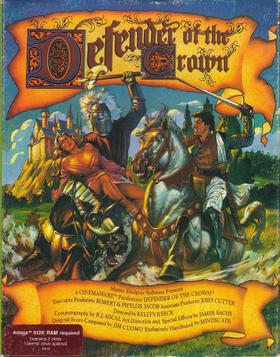
Defender of the Crown is a strategy video game designed by Kellyn Beeck. It was Cinemaware's first game, and was originally released for the Commodore Amiga in 1986, setting a new standard for graphic quality in home computer games.

Captain Blood is a French video game made by ERE Informatique and released by Infogrames in 1988. It was later re-released in the UK by Players Premier Software.

Uninvited is a black-and-white horror-themed point-and-click adventure game. It was originally developed for the Macintosh by ICOM Simulations released in 1986 by Mindscape as part of the MacVenture series.
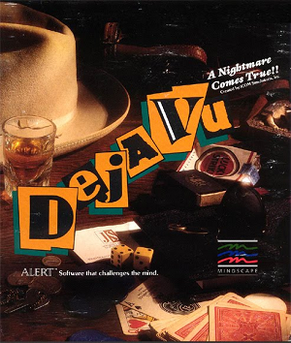
Déjà Vu is a point-and-click adventure game set in the world of 1940s hardboiled detective novels and films. It was released in 1985 for Macintosh – the first in the MacVenture series – and later ported to several other systems, including the Amiga. Initially, the game featured black and white graphics, and later releases introduced color.

The Sentinel, released in the United States as The Sentry, is a puzzle video game created by Geoff Crammond, published by Firebird in 1986 for the BBC Micro and converted to the Commodore 64, Amstrad CPC, ZX Spectrum, Atari ST, Amiga and IBM PC compatibles. The Sentinel was among the first games to use solid-filled 3D graphics on home computers. It won numerous awards upon release and has since appeared on several "best video games of all time" lists.

The Three Stooges is a video game released by Cinemaware in 1987 for the Amiga based on the comedy trio of the same name. Players control Stooges Moe, Larry, and Curly in minigames based on Stooges films with the aim of raising enough money to save an orphanage. It was ported to the Apple IIGS, Commodore 64, MS-DOS, NES and Game Boy Advance. The game has been praised as a faithful adaptation of the Stooges films, but has been criticized for repetitive gameplay and limited replay value.

The Faery Tale Adventure is a 1987 action role-playing video game designed by David Joiner and published by MicroIllusions for the Amiga, and later ported to the Commodore 64, MS-DOS, and Sega Genesis. The MS-DOS version is titled The Faery Tale Adventure: Book I. Microillusions also released a "Book 1" version for the Amiga which was going to be the start of a series of games, according to Talin, but bankruptcy prevented it. The initial version was produced for the Amiga 1000 and featured the largest game world to that date. A sequel, Faery Tale Adventure II: Halls of the Dead, was released in 1997.

Wizardry: Proving Grounds of the Mad Overlord is the first game in the Wizardry series of role-playing video games. It was developed by Andrew Greenberg and Robert Woodhead. In 1980, Norman Sirotek formed Sir-Tech Software, Inc. and launched a beta version of the product at the 1980 Boston Computer Convention. The final version of the game was released in 1981.

GATO is a real-time submarine simulator published in 1984 by Spectrum HoloByte for MS-DOS. It simulates combat operations aboard the Gato-class submarine USS Growler (SS-215) in the Pacific Theater of World War II. GATO was later ported to the Apple IIe, Atari ST, and Mac. In 1987, Atari Corporation published a version on cartridge for the Atari 8-bit computers, to coincide with the launch of the Atari XEGS.

Moebius: The Orb of Celestial Harmony is a video game produced by Origin Systems and designed by Greg Malone. It was originally released in 1985 for the Apple II. Versions were also released for the Amiga, Atari ST, Commodore 64, Macintosh, and MS-DOS. The game is primarily a top-down view tile-based role-playing video game, but it has action-based combat sequences which use a side view, roughly similar to games such as Karateka.
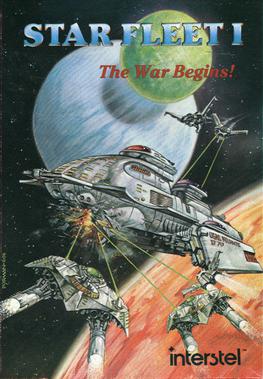
Star Fleet I: The War Begins is a 1984 strategy video game designed by Trevor Sorensen and developed by Interstel. It was released for Apple II, MS-DOS and Commodore 64. Versions for the Commodore 128, Atari ST, and Atari 8-bit computers were released in 1986 and versions for the Amiga and Mac were released in 1987. The game was successful enough to spawn sequels which are collectively known as the Star Fleet series.

Shanghai is a computerized version of mahjong solitaire published by Activision in 1986 for the Amiga, Atari ST, Atari 8-bit computers, Commodore 64, MS-DOS, classic Mac OS, Apple IIGS, and Master System. Shanghai was originally programmed by Brodie Lockard. It was released as an arcade video game by Sunsoft in 1988.
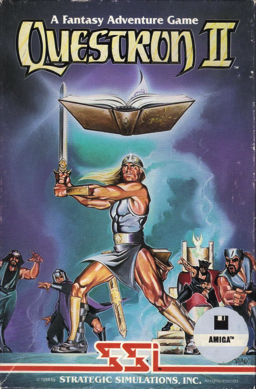
Questron II a 1988 role-playing video game published by Strategic Simulations for the Apple II, Apple IIGS, Atari ST, Commodore 64, IBM PC, and Amiga. It is the sequel to 1984's Questron. The story and original design is credited to Quest Software, the programming and artwork is credited to Westwood Associates.
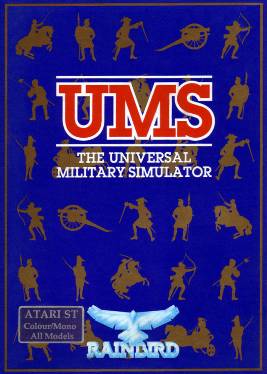
The Universal Military Simulator is a computer game developed by Rainbird Software in 1987 for the Macintosh, Tandy 4000, and IBM PC compatibles. In 1988, both Atari ST, Amiga versions were released. The game was created by Ezra Sidran. The PC and Amiga versions were ported by Ed Isenberg. The game spawned two sequels: UMS II: Nations at War and The War College: Universal Military Simulator 3.

PT-109 is a naval simulation video game developed by Digital Illusions and Spectrum HoloByte in 1987 for the Macintosh and MS-DOS. This game is roughly based on the events involving the Motor Torpedo Boat PT-109.

Harpoon is a computer wargame published by Three-Sixty Pacific in 1989 for DOS. This was the first game in the Harpoon series. It was ported to the Amiga and Macintosh.

Falcon is a combat flight simulator video game and the first official entry in the Falcon series of the F-16 jet fighter's simulators by Spectrum HoloByte. Originally developed by Sphere for Macintosh and MS-DOS in 1987 and ported to several platforms between 1988 and 1992, the game earned commercial success and critical acclaim.

The Hunt for Red October is a video game based on the 1984 book The Hunt for Red October by Tom Clancy. It was released in 1987 and was available for the Atari ST, Amiga, Apple II, Macintosh, ZX Spectrum, MSX, Commodore 64, and IBM PC. A port for the Apple IIGS was released in 1989. The game is a combination of submarine simulator and strategy game. The player navigates the Red October towards U.S. waters while avoiding the Soviet Navy.

The Fidelity Chessmaster 2100 is a 1988 video game published by The Software Toolworks. An Atari ST version was advertised but never released. A Sega Mega Drive version was also planned and shown at Winter CES 1992 but was never released.
References
- ↑ Chamberlain, Bill (1984). The Policeman's Beard Is Half Constructed . UbuWeb, Warner Books. ISBN 0-446-38051-2 . Retrieved 2009-07-02.
- ↑ Kane, Christine L. (October 13, 1981). "Computing fiction: William Chamberlain's programmed fantasy". The Boston Phoenix. Retrieved May 22, 2024.
- ↑ Leah, Henrickson (April 4, 2021). "Constructing the Other Half of The Policeman's Beard". Electronic Book Review . Open Humanities Press. doi:10.7273/2bt7-pw23 . Retrieved January 20, 2022.
- ↑ Chamberlain, Bill, Getting a Computer to Write About Itself , Atari Archives, accessed Aug. 17, 2007.
- ↑ The Racter FAQ, accessed August 17, 2007.
- ↑ Kane, 1981
- ↑ Nasta, Terry (1984-12-25). "Thief of Arts". PC Magazine. p. 63. Retrieved 25 October 2013.
- ↑ Wagner, Roy (May 1986). "Amiga Preferences". Computer Gaming World. p. 36.
- ↑ Lewis, Peter H. (May 14, 1985). "A New Brand of Lunacy For Sale". The New York Times. Retrieved January 20, 2022.
- ↑ "Jeux & stratégie 47". October 1987.